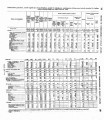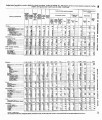| OCR Text |
Show REPORT OF CO~~MISSIONER OF INDIAN AFFAIRS 13 continued alarming. The timber offered as the Paiute unit in 1928, for which no bids were received, was combined with other timber at the north and west and again offered as the Black H i s unit. How- ' ever, the damage already caused by forest insects was so great that no one was w i h g to bid even the minimum price of $4 for pondosa pine. The timber on a large unit 1 ' g north of the Black H~lls, destgnated as the Sycan unit, was s o l g t a price of $6.92 for pondosa pine and prices of $2 and $1 for inferior species, of which there are small amounts. In view of the great reduction in volume that has already resulted from insect attack the price of $6.92 is considered very advantageous from the standpoint of the Indians, even if the infestation should at once subside. On the Creek unit lyin along the reservation border south of Yainax and Beatty, pon80sa pine brought a price of $7.12 per t ousand feet, and s small unit of 24,000,000 feet west of the Whiskey % reek unit sold for $5.77. All of these units were offered, in contravention of the policy of restricted sales, because of the probability that a recurrence of an insect infestation such as occurred in 1926-27 might destroy a large part of the mature timber that had survived the earlier attacks. Under the requirements of the decision of the Supreme Court of the United States in the case of United States v. Payne (264 U. S. 446), the greater part of the timberlands of the Quinaielt Indian Reservation, Wash., have been allotted to individual Indians. These lands are generally entirely unfitted for agricultural use and the only means by which the allottees can secure any benefit from the aliotments consists in the sale of the timber. Because of the need of many Indians for funds and indications that the removal of certain large timber operators from the Quinaielt territoq in, the near future ht d i h co mpetition, four large units comprising all unsold ti?m e r on the Quinlwelt Reservation and known as the Lunch Creek, Joe Creek, Raft River, and Cape Elizabeth units, were advertised for a period of nearly four months with sealed bids opened on June 18, 1929. After the advertisements were issued amounce-ment was made that the Northern Pacific and Union Pacific Rail-ways had decided to submit an application to the Interstate Com-merce Commission for the rivilege of building a co-on carrier railroad across Quinaielt I! eservation to the Hoh River. This announcement moused great interest for and against the proposed sales. While bids were invited and received upon the four units mentioned, after the close of the fiscal year a11 of these bids were rejected. In September, 1928, more than one-half biion feet of pondosa pine on the DeGance Plateau unit in the Southern Navajo jvsdic-tion was sold at the rate of $3 per thousand feet. About 20 miles of railroad must be built from the Atchison, Topeka & Santa Fe Rail-way to reach the edge of this tract of timber. As reproduction is very deficient in this area because of excessive grazing by sheep and goats, a very d i c u l t roblem in silviculture exists. While operators on Indian lands have generally complained as to the inadequacy of profits, large investments in mills and lo ging equipment have practically forced them to operate on a fairly 7 arge scale each year. During the fiscal year 1928 contractors cut timber from Indian lands with a value of $2,541,426, and, in addition to 76019-29-2 |

















































